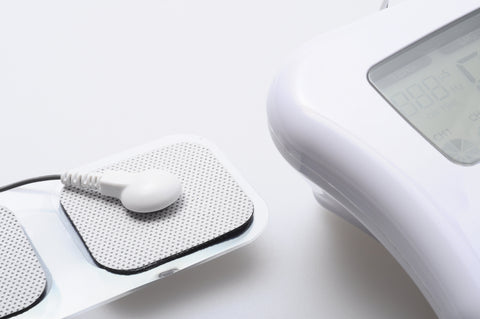
Electrical muscle stimulation (EMS), also known as neuromuscular electrical stimulation (NMES) or electromyostimulation, is the elicitation of muscle contraction using low-volt electrical impulses. EMS differs from TENS in that it is designed to stimulate muscle motor nerves, while TENS is designed to stimulate sensory nerve endings to help decrease pain.
EMS is used to prevent or reduce muscle atrophy. Atrophy is the weakening and loss of muscle tone, which is usually experienced after surgeries or injuries. EMS has proven to be an effective means of increasing blood flow to muscles, increasing range of motion, increasing muscle strength, as well as enhancing muscle endurance. EMS can help reduce pain when it is caused by a muscle-related pain, such as a spastic muscle, sore muscles, or tight muscles. EMS deals with muscles, while TENS deals with nerves.
Studies have shown that EMS stimulates large nerve axons (long outgrowths of a nerve cell body), some of which you cannot stimulate voluntarily. It is possible that EMS might allow for additional muscle hypertrophy (increased development of tissue by enlargement, without multiplication of cells). EMS can increase muscle growth, endurance and strength. EMS may be used only for this or with regular weight training by aiding recovery and helping muscles grow and get stronger. EMS can increase body temperature, heart rate and metabolism (promoting energy and fat absorption from the body).
EMS has received increasing attention in the last few years, because of its potential to serve as a strength training tool for healthy subjects and athletes, a rehabilitation and preventive tool for partially or totally immobilized patients, a testing tool for evaluating the neural and/or muscular function in vivo, and a post-exercise recovery tool for athletes. Sports scientists have attributed the use of EMS as a complementary technique for sports training.
While using the EMS, the brain sends a nerve impulse to the “motor point” of your muscle, which causes the muscles to expand and contract. Place the electrodes over the muscle group to be stimulated. When the EMS is applied through those pads, the signal finds its way to these motor points and causes the muscle to expand and contract. This works just like exercise, similar to an isometric exercise. During an exercise, your brain sends a message down the spinal cord through the nerves with all of the muscles you're using that causes them to relax and contract. This is called voluntary muscle action. Your brain is controlling the muscle. EMS uses an outside electrical source to do the same thing. The current passes through your skin to the nerves in that area, causing the muscle to expand and contract. EMS actually stimulates muscles that you can't normally exercise voluntarily. This allows you to train muscles that may normally have little activity.
During therapy, electrodes are placed on the patient’s skin, sending tiny electrical pulses to various areas of the body to help curtail muscle spasms, reduce inflammation, and relieve pain. Other uses for electrical stimulation include helping to heal bone fractures, enhance medication delivery through the skin, heal skin incisions, and more.
EMS can also be used for athletic training for treating swelling and/or pain, particularly in the acute stage of the healing process when the injury is brand new, and the swelling and pain inhibit function or progress. It treats the pain by stimulating the large nerve fibers, which often override smaller nerve fibers that are producing the pain.
Luigi Galvani (1791) provided the first scientific evidence that current can activate muscle. During the 19th and 20th centuries, researchers studied and documented the exact electrical properties that generate muscle movement. It was discovered that the body functions induced by electrical stimulation caused long-term changes in the muscles. In the 1960s, Soviet sport scientists applied EMS in the training of elite athletes, claiming 40% force gains. In the 1970s, these studies were shared during conferences with the Western sport establishments. However, results were conflicting, perhaps because the mechanisms in which EMS acted were poorly understood. Recent medical physiology research pinpointed the mechanisms by which electrical stimulation causes adaptation of cells of muscles, blood vessels and nerves.